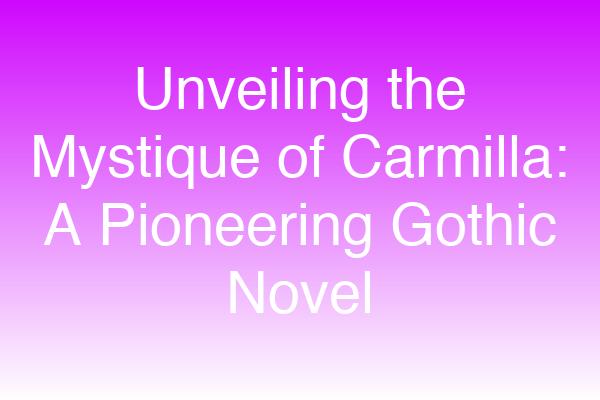
Introduction: The Allure of "Carmilla"
In the realm of Gothic literature, few works have left as profound an impact as "Carmilla." Written by Joseph Sheridan Le Fanu and published in 1872, this novella not only pioneered the vampire genre but also introduced themes of female sexuality and psychological horror that resonate even today. As we delve into the depths of this captivating tale, we will explore its historical context, thematic elements, and lasting influence on literature and popular culture.
The Historical Context of "Carmilla"
"Carmilla" emerged during a time when Gothic fiction was flourishing. The Victorian era, marked by strict social norms and a fascination with the supernatural, provided fertile ground for Le Fanu's exploration of taboo subjects. Unlike Bram Stoker's "Dracula," which came two decades later, "Carmilla" centers on a female vampire and her complex relationship with the protagonist, Laura. This focus on female characters was revolutionary, challenging the male-centric narratives prevalent in literature of the time.
The Setting: A Haunting Atmosphere
The story unfolds in a remote castle in Styria, Austria, where Laura lives a sheltered life. The eerie setting, complete with dark woods and an ancient castle, creates a palpable sense of dread and suspense. Le Fanu's vivid descriptions transport readers to a world where the supernatural intertwines with the mundane, enhancing the Gothic atmosphere that is a hallmark of the genre.
Thematic Elements: Love, Desire, and Horror
At its core, "Carmilla" is a tale of forbidden love and desire. The relationship between Laura and Carmilla is fraught with tension, as Carmilla embodies both attraction and danger. This duality reflects the Victorian anxieties surrounding female sexuality and the fear of the "other." The novella explores themes of identity, seduction, and the blurred lines between love and horror, making it a rich text for analysis.
Female Empowerment and Sexuality
One of the most striking aspects of "Carmilla" is its portrayal of female empowerment. Carmilla is not a passive character; she is assertive, seductive, and unapologetically herself. This representation of a strong female figure was groundbreaking for its time and has inspired countless interpretations in modern literature and media. The novella invites readers to question societal norms and the stigmas surrounding female desire.
The Legacy of "Carmilla"
"Carmilla" has left an indelible mark on the vampire genre and Gothic literature as a whole. Its influence can be seen in various adaptations, including films, television series, and even graphic novels. Notably, the character of Carmilla has inspired modern interpretations of vampires, often portrayed as complex figures grappling with their identities and desires.
Modern Adaptations and Cultural Impact
Recent adaptations, such as the web series "Carmilla" and various films, have reimagined the story for contemporary audiences, emphasizing its themes of LGBTQ+ identity and empowerment. These adaptations highlight the novella's relevance in today's discussions about sexuality and representation, proving that "Carmilla" is not just a relic of the past but a living text that continues to resonate.
Conclusion: Embracing the Darkness
In conclusion, "Carmilla" stands as a testament to the power of Gothic literature to explore complex themes of love, identity, and desire. Its pioneering portrayal of female characters and its haunting narrative have solidified its place in literary history. As we reflect on the impact of this Gothic novel, we invite you to delve into its pages and discover the dark allure of Carmilla for yourself.
Call to Action
Have you read "Carmilla"? What are your thoughts on its themes and characters? Share your insights in the comments below, and don't forget to explore other Gothic novels that challenge societal norms and delve into the human psyche.
By following these guidelines, this blog post not only provides a comprehensive overview of "Carmilla" but also engages readers and optimizes for search engines, ensuring it reaches a wider audience interested in Gothic literature.